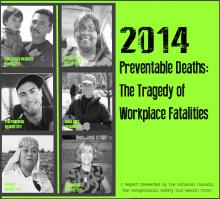
by Brianna Crandall — May 7, 2014—The National Council on Occupational Safety and Health (National COSH) has released its annual report on preventable deaths in the U.S. workplace. More than 50,000 U.S. workers die each year due to occupational injuries and illnesses, according to the report. Preventable Death 2014 features analysis of the scope of the problem and high-risk groups; case studies of seven preventable deaths; a section on the dangers of silica dust; recommendations for action to reduce workplace hazards; and an update on the activities of local COSH groups.
“No one should have to risk their life simply to earn a living,” said Jessica Martinez, deputy director of National COSH, which links the efforts of local worker health and safety coalitions in communities across the United States, advocating for elimination of preventable hazards in the workplace. “Many of the injuries and illnesses that are killing American workers can be prevented. We know the safety systems, equipment and training that can stop people from dying on the job, and it’s absolutely urgent that we take action to protect workers and their families.”
Preventable Death 2014 combines data collected by the U.S. Bureau of Labor Statistics (BLS) on fatal workplace injuries with projections from peer-reviewed data on fatalities resulting from workplace illnesses such as cancer and respiratory, cardiovascular and renal disease.
The report from National COSH was released in advance of Workers’ Memorial Week of Action, a global event that commemorates workers who lost their lives on the job. In the United States, more than 50 local communities in 27 states honored fallen workers.
Preventable Death 2014 documents the high rate of workplace fatalities due to injury experienced by Hispanic workers—4.2 deaths per 100,000 workers in 2012, compared to 3.7 deaths per 100,000 for the U.S. population as a whole. This pattern of high risk for Hispanic workers, the report shows, has continued for at least the past five years.
“We know that Hispanic workers are in high-hazard jobs, and training and communication make a huge difference, so we need to make sure training is available for all workers in a language they understand,” said Martinez. “That includes informing workers of their rights during any safety inspection that takes place in their workplace.”
Preventable Death 2014 also identifies specific strategies to reduce workplace hazards in the six areas identified by BLS as leading causes of workplace fatalities: transportation incidents, contacts with objects and equipment, falls to a lower level, workplace violence, exposure to harmful substances and environments, and fires and explosions.
In addition to Preventable Death 2014, released on April 23 by National COSH, local health and safety coalitions in California, Massachusetts, New York, Tennessee, Texas and Wyoming also released reports on workplace fatalities in their individual states in conjunction with Worker Memorial Week activities.





